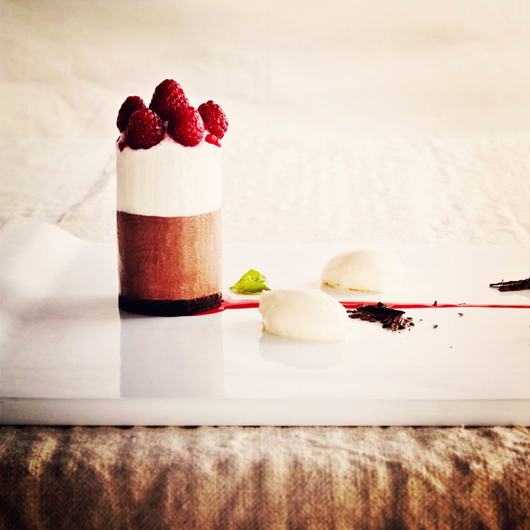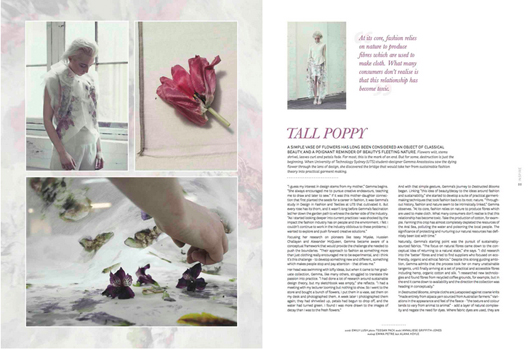My Advice: Getting Published
 {Photographs by Natalie McComas, published in Frankie Magazine}
{Photographs by Natalie McComas, published in Frankie Magazine}
By Lizzie Stafford
Getting your work out there is one of the most important aspects of being a creative practitioner, but everyone knows getting published isn't easy. So how do you approach an editor? How do you let them know your work is good enough or the right fit for their magazine, blog, book or website? Here, a photographer, a stylist, an editor/writer, an illustrator and a blogger/author/crafter offer their (invaluable) words of advice.
Have an up-to-date, clean and easy-to-navigate website.
Natalie McComas, photographer
"I feel that every photographer's journey into the publishing world can be a different one.
For me, it's been a combination of editors contacting me via my website, networking with other creatives, submitting article ideas and folios, photographers referring me for jobs and also knowing the right people at the right time.
I'd definitely say that having an up to date, clean and easy-to-navigate website, with all the right key words for search engines, to be a pretty important part of not only getting work, but also getting published. It is, after all, your 'shopfront' available 24/7 for browsing. I've had international magazines contact me to shoot for them just from Googling photographers in my area. Once, I was asked by an editor in London to shoot an interior story for their magazine - even though I didn't have any interior shots on my site. They liked my style, saw I had credentials and knew I'd be able to do the job the way they needed it done.
If you are submitting work, firstly, do your homework to make sure it is not something that has been featured elsewhere recently! It is best if the pitch is succinct and with all relevant links/ facts/ accompanying photos to make it super easy for your contact to look through and evaluate.
Whilst making submissions do not get discouraged if you don't get a reply straight away. Sometimes I've heard back from editors three months later from when I actually pitched the idea. If you don't hear back or if you are rejected, don't take it personally. Keep your chin up and think about how you can make your next submission a little better."
Know your magazines.
Lyndel Miller, stylist
"I still get a kick out of seeing my work grace the pages of a magazine. As I start writing this I am reminded that there is a lot to know about this process. I am a published cookbook author, have produced and styled books for others and am now writing my second cookbook/styling book for release in 2015. I love books! I equally love magazines and love to encourage others.
There is a process for the stylist when looking to get published. There is one for the photographer and one also for the writer. This is also a collaborative process. I think the single most important thing to take on board for all parties if you are dreaming of photographing, styling, or writing for an interior editorial is to know your magazines. It's the best place to start.
Really know them. This might be stating the obvious, though I find those I mentor are not always attuned to this. Subscribe to the ones you would like to submit to.
Ask yourself: Who is their audience? What style of homes are they constantly featuring? What is the writing style? What is the style of photography?
Look beyond the gloss on pages to the formula. Read them! Know your editors, read their work. They are the essence of their magazines. Then look at whether your style and your crew you have chosen to collaborate with can cater to this.
An editorial submission is not just about you and your work but that of a photographer, and perhaps a writer if you decide to team up with one and offer a magazine the whole package.
Not all photographers are the same. Not all writers are the same. This applies to stylists also. Choose to work with those that exhibit talent for the field you wish to pursue. A like-minded team is very important. Ideally, team up and collaborate with a crew that already has contacts in the industry. This can be very helpful. Collaboration is key! A photo stylist cannot showcase ones work without a photographer. Building a relationship with a photographer is paramount."
Pitch often and pitch well.
Emily Lush, freelance writer/editor
"When you’re trying to get published, rejection is inevitable but feedback is invaluable. Pitch often and pitch well - not only will it improve your chances of getting published, but pitching is a great way to access feedback. Whether it’s an auto reply or a thoughtful piece of constructive criticism, take every rejection letter you receive and learn something from it.
No matter how many leads you’ve chased, interviews you’ve transcribed or background research you’ve enveloped yourself in, no idea is ever wasted, and no time you invest in a story you’re passionate about is ever wasted time. Getting published might be your end goal, but professional writing is a process. One of the first feature articles I ever wrote was shot down in flames by the magazine I pitched to - so into the desk drawer it went. When I had the opportunity to revisit the subject for a different publication several years later, I already had the knowledge, so I was able to build on my original ideas, reconnect with old contacts and write a stronger feature. Better still, my initial awareness on the topic had subconsciously forced me to pay attention to every little tidbit of information I came across in the interim. The story that I eventually published took a few days to write, but it had been in development for three years - becoming richer and more refined with every passing day.
There’s nothing wrong with recycling your old ideas or contacts - the best stories take time to produce. Now that I work on the other side of the desk sorting submissions (at Peppermint Magazine), I often see writers come back again and again with ideas they’ve polished or new ones they’ve pursued. Showing a publication that you’re willing to persevere - and to learn and bounce back from rejection - proves that you’re committed.
Once you have momentum, keep it rolling. I highly recommend using an online portfolio or blog to catalogue your published and unpublished work. If you use a blog, you can track your progress as a writer and curate your own content, which can be a helpful motivator if you’re struggling to get your ideas noticed. An online portfolio is also a great way to store your ideas and inspirations - return to them again and again, make links between old and new, and keep creating."
Get ready to hear the word no.
Amy Borrell, illustrator
"I first started freelancing as an illustrator a few years ago and in the beginning, getting my work out into the world and published was all a bit of a mystery. But through a fair bit of trial and error I've learnt a few tricks that will hopefully help increase the chances of your work being seen - and commissioned! - by the right people.
Do good work! It sounds simple, but if you don't like your own work, chances are noone else will. Identify potential publications with a similar aesthetic to your own. Reaching out to likeminded people will increase the chances of a response.
Try to find the Art Director's name of said publication so you can contact them directly. Be personal, polite and straight to the point. Clients are generally busy people, so you have to give them a reason to read your email over the hundreds of others that may be lining their inbox. Use their name at the beginning, a clear subject line and a short cheery email introducing yourself with a link to your online portfolio.
Get ready to hear the word no - or nothing at all! It happens a lot when you're first starting out, but with a little perseverance you'll stumble upon people who will genuinely love and support your work!"
Be innovative, surprising, authentic, fresh!
Pip Lincolne, author, blogger, crafter
"My advice to creatives who want to be published is this: have a blog or website where you can showcase your work. Editors not only need to be able to read your work, they need to be able to FIND you if they Google you! Be innovative, surprising, authentic, fresh! Offer your own unique self out to the world, there is nobody like you and this is your chance to show who you really are.
Be humble and thankful for any help you get along the way and promote the work of other creatives you love to build a little community around you. If you want to write a book or appear in your favourite magazine, interact with publishers either on platforms like Instagram and Facebook - or just email them a short, polite, personal email telling them about the good things you are doing. If you email a publisher or editor, keep it short and sweet and include any relevant information about your work PLUS a low res image (with a ink to a hi-res online version). Make your email short but compelling to make publication/further research easier for the recipient.
And finally work hard, be nice to people and never give up! It takes time to be successful! Don't be disheartened if it's slow progress. Slow going is better than no-going, if publication is your dream! Keep going at your craft and soldier on!"
Lizzie Stafford is a freelance writer and editor and owns and runs Künstler, an independent magazine and bookstore based in Winn Lane, Brisbane. She is the Brisbane events coordinator for CWC.



